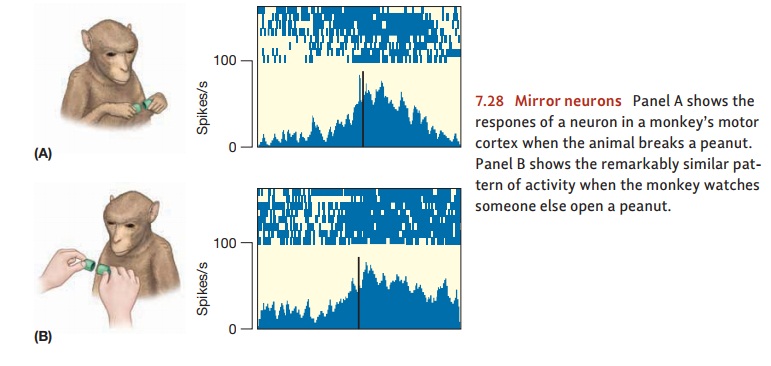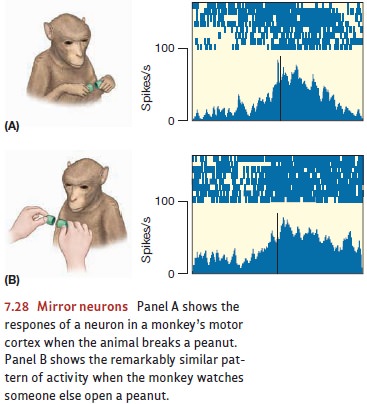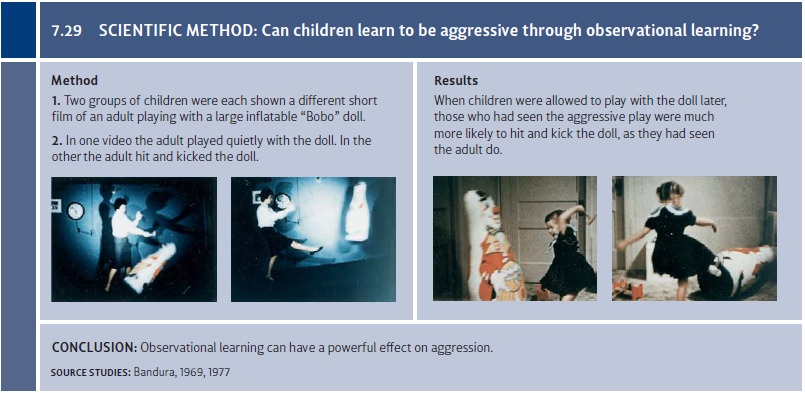Chapter: Psychology: Learning
Observational Learning

OBSERVATIONAL
LEARNING
We’ve now considered three types
of learning—habituation, classical conditioning, and instrumental conditioning,
each of which can be observed in many different species. Indeed, across we’ve
mixed together examples of how these learn-ing principles apply to humans and
how they apply to a range of other organisms. In contrast, a fourth type of
learning was for many years regarded as exclusively human; but more recent
evidence indicates that this learning, too, can be observed in many

species. At issue here is observational learning—a process
through which we watch how others behave and learn from their example.
Other species are certainly
capable of observational learning (e.g., Bugnyar & Kotrschal, 2002; White
& Galef, 1998). For example, monkeys are capable of vicarious conditioning—acquiring a fear response, triggered by a
specific stimulus, merely by watching another monkey show fear in response to
that stimulus (Mineka & Ben Hamida, 1998; Ă–hman & Mineka, 2001). This
learning is prob-ably supported by a specific type of neuron found in the
brains of many species: These mirror
neurons are located in the frontal lobe, near the motor cortex, and fire
whenever an animal performs an action such as stretching out its arm or
reaching toward a target (Figure 7.28). Remarkably, the same neurons fire when
the animal observes someone else performing the same action (Rizzolatti &
Craighero, 2004); and several theorists have suggested that these neurons play
an essential role both in understanding others’ behav-ior and in imitating that
behavior.
Observational learning can also
be documented in non-primate species. In one experi-ment, pigeons were allowed
to observe other pigeons getting rewarded either for pecking at a disk or for
stepping on a lever. When the “watchers” were then placed in the same
exper-imental chamber, they tended to make the same response—pecking or
stepping—they had observed earlier (Zentall, Sutton, & Sherburne, 1996).
Observational learning—and
imitation in particular—also plays a central role for humans, even when we’re
very young (e.g., Bandura, 1977, 1986). Indeed, infants less than a month old
imitate the facial expressions of people in their environment (e.g., Meltzoff
& Moore, 1977); not much later, they start imitating a range of other
behaviors. Sometimes human imitation takes the form of outright
mimicry—duplicat-ing, as best we can, the exact behaviors we have observed in
others. At other times, the imitation is more sophisticated: We observe others
and draw general conclusions about what sorts of behaviors are permissible in
that situation.
We can see both forms of
imitation at work in a classic study by Bandura (1969, 1977; Figure 7.29). In
that study, children watched while an adult punched and kicked a large,
inflated doll. Later on, the children were allowed to play in the room with
various toys; and those who had observed the adults’ aggression tended to mimic
it—kicking and punching the doll exactly as the adult had. But these children
also showed a broader form of imitation: They became aggressive toward other
toys, as if they’d figured out by observation that aggression was permitted and
maybe even appropriate in this environment.

As a further illustration of
observational learning, consider the impact of media violence—seen on TV or in
video games—on children. Research has made it clear that media violence—whether
it’s watching cartoon characters punch each other or guiding videogame
characters as they rip each other apart—does encourage violence in child
viewers (e.g., C. Anderson & Bushman, 2002; Bushman & Anderson, 2009;
Carnagey
Anderson, 2005; Feshbach & Tangney, 2008), Indeed, the evidence is compelling enough that six major professional societies (including the American Psychological Association and the American Medical Association) issued a joint statement noting that studies “point overwhelmingly to a causal connection between media violence and aggressive behavior in some children”. This effect proba-bly involves several different mechanisms; still, it’s a compelling example of just how important observational learning can be—and it reminds us that this learning can have both good effects (the acquisition of new skills) and bad.
Related Topics